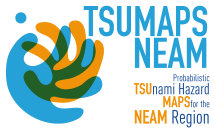The goal of Probabilistic Model is the review of the probabilistic framework to assess, at all target coasts, the probability of exceedance of different intensity levels within different exposure times. The model will enable the quantification of both aleatory and epistemic uncertainties.
As for the previous components of PTHA described in Earthquake Model and Tsunami Modelling, this probabilistic framework has been under development for several years now, not only in tsunami hazard projects and efforts, but also while dealing with seismic and volcanic hazard (e.g., FP7 REAKT, STREST, MEDSUV, VUELCO). This framework is now being specifically developed for ASTARTE and for other national assessments.
The method will allow us to consider all the types of information produced in Earthquake Model and Tsunami Modelling. The aleatory uncertainty on seismic sources, reflecting the intrinsic unpredictability of the next natural events, is here treated with an event tree and by sampling the PDF of the earthquake model parameters. The epistemic uncertainty, due to our presently limited knowledge of the studied phenomena, is treated by exploring alternative scientifically acceptable models with Bayesian procedures.
An overall ensemble model will be developed in order to combine all the alternative models to enable a simultaneous quantification of both aleatory and epistemic uncertainty, allowing us to consider different credibility levels for all alternative models. The treatment of this subjectivity will be homogenized to international and European standards (e.g., SSHAC 1997, STREST), and its effect on the quantified hazard.
